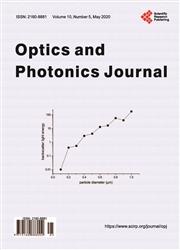A Multi-Parameter Sensor Based on Cascaded Photonic Crystal Cavities Filled with Magnetic Fluid
引用次数: 0
Abstract
A kind of photonic crystal (PC) micro-cavity sensor based on magnetic fluid (MF) filling is designed with simulation model. Generally, many sensors’ designs are based on a universal temperature in the whole structure. However, strong photothermal effect in high Q micro-cavities will lead to different temperatures between cavities and environment inevitably. In many theoretical PC sensor designs, researchers neglected the different temperature between environment and cavities. This simple hypothesis will probably lead to failure of sensor design and get wrong temperature. Moreover, few theoretical or experimental works have been done to study optical cavity’s heating process and temperature. We propose that researchers should take seriously about this point. Here, the designed cascaded micro-cavity structure has three spectral lines and a reversible sensitivity matrix, which can simultaneously detect magnetic field, ambient temperature and MF micro-cavity temperature. It can solve the magnetic field and temperature cross-sensitivity problem, and further, distinguish the different temperatures of environment and magnetic fluid cavities. The influence of hole radius and slab thickness on the depth and Q value of the resonant spectral line are also studied. Responses of three dips to magnetic field, ambient temperature and MF micro-cavity temperature are simulated, respectively, where dip 1 belongs to MF cavity 1, dip 2 and dip 3 belong to MF cavity 2. The obtained magnetic field sensitivities are 2.89 pm/Oe, 4.57 pm/Oe, and 5.14 pm/Oe, respectively; the ambient temperature sensitivities are 65.51 pm/K, 50.94 pm/K, and 58.98 pm/K, respectively; and the MF micro-cavity temperature sensitivities are −14.41 pm/K, −17.06 pm/K, and −18.81 pm/K, respectively.基于磁流体级联光子晶体腔的多参数传感器
设计了一种基于磁流体填充的光子晶体微腔传感器,并建立了仿真模型。一般来说,许多传感器的设计都是基于整个结构的通用温度。然而,高Q微腔中强烈的光热效应将不可避免地导致腔体与环境之间的温度差异。在许多理论上的PC传感器设计中,研究人员忽略了环境和腔体之间的温度差异。这种简单的假设很可能导致传感器设计失败,得到错误的温度。此外,对光腔加热过程和温度的理论和实验研究较少。我们建议研究人员应该认真对待这一点。本文设计的级联微腔结构具有3条谱线和一个可逆灵敏度矩阵,可以同时检测磁场、环境温度和中频微腔温度。解决了磁场与温度的交叉敏感问题,进一步区分了不同温度的环境和磁流体腔体。研究了孔半径和板料厚度对共振谱线深度和Q值的影响。分别模拟了三个倾角对磁场、环境温度和中频微腔温度的响应,其中倾角1属于中频腔1,倾角2和倾角3属于中频腔2。得到的磁场灵敏度分别为2.89 pm/Oe、4.57 pm/Oe和5.14 pm/Oe;环境温度敏感度分别为65.51 pm/K、50.94 pm/K和58.98 pm/K;中频微腔温度灵敏度分别为- 14.41 pm/K、- 17.06 pm/K和- 18.81 pm/K。
本文章由计算机程序翻译,如有差异,请以英文原文为准。
求助全文
约1分钟内获得全文
求助全文

 求助内容:
求助内容: 应助结果提醒方式:
应助结果提醒方式:


